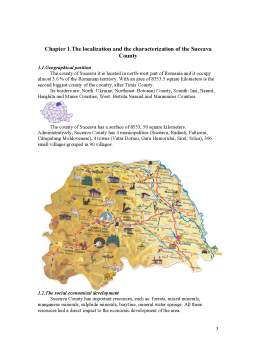Cuprins
- Chapter 1.The localization and characterization of the Suceava County.3
- 1.1. Geographical position and the touristy map.3
- 1.2. The social economical development.3
- 1.3. Road access.4
- Chapter 2.The presentation of the tourism potential in Suceava County.5
- 2.1. Natural resources.5
- 2.1. Atrophic resources .6
- Chapter 3.The analyzes of the general and specific infrastructure.7
- 3.1. The general infrastructure.7
- 3.1.1. Transport infrastructure.7
- 3.1.2. Utility infrastructure.7
- 3.1.3. Wealth infrastructure.7
- 3.1.4. Telecommunication infrastructure.8
- 3.2. Specific infrastructure.8
- Chapter 4.The analyzes of the tourism circulation.10
- Chapter 5.The prevision of the future development. The prevision of the touristy arrivals in period 2007-2009.11
- 5.1. Absolute modification mean.11
- 5.2. Relative index of the modification mean.12
- 5.3. Linear trend.13
- Chapter 6.Proposal for the tourism potential capitalization.14
Extras din proiect
Chapter 1.The localization and the characterization of the Suceava County
1.1.Geographical position
The county of Suceava it is located in north-west part of Romania and it occupy almost 3.6 % of the Romanian territory. With an area of 8553.5 square kilometers is the second biggest county of the country, after Timis County.
Its borders are: North: Ukraine, Northeast: Botosani County, Sounth: Iasi, Neamt, Harghita and Mures Counties, West: Bistrita.Nasaud and Maramures Counties.
The county of Suceava has a surface of 8553, 50 square kilometers.
Administratively, Suceava County has 4 municipalities (Suceava, Radauti, Falticeni, Câmpulung Moldovenesc), 4 towns (Vatra Dornei, Gura Humorului, Siret, Solca), 396 small villages grouped in 90 villages.
1.2.The social economical development
Suceava County has important resources, such as: forests, mixed minerals, manganese minerals, sulphide minerals, barytine, mineral water springs. All these resources had a direct impact to the economic development of the area.
Representative industrial branches in the county of Suceava are: forestry and wood processing developed in direct correlation with the big surface of the forester fund, pulp and paper industry (the biggest company in this industry is S.C. “Ambro”S.A. Suceava), the food industry based on the milk and meat production, the cars production industry, the mining and non-metalliferous ore processing industry, the textile and footwear industry and chemical industry.
Food industry activity is organized 10 principal branches, the number of economical agents being in continuous increase. The representative units of superior capitalization of farming production are: SC”LaDorna”SA Vatra Dornei, SC ”Raraul” SA Campulung Moldovenesc,SC”Facos”SA Suceava etc.
In 2006 compared with 2005, there has been an increase in the volume of turnover with 29.0% in industry, electricity, gas and water and a decrease the volume of turnover
with 28.4% in the extractive industry, with 7.2% in manufacturing.
The arable land spans over 42% from the county area. The main crops are: cereals, potatoes, sugar beet, sun flower, vegetables and fodder. The soil and climate conditions favored the development of orchards. This activity is concentrated especially in Falticeni area. The villages from the mountain area are specialized in animal breeding, mainly milking cows and sheep.
Suceava County has 714.000 inhabitants, being in the seventh position following this item. Out of the total, 458.000 inhabitants (60% from the County population) are rural population, and 256.000 inhabitants (36%) are urban.
Over 50% from the County surface are mountain area, and from this reason the average density of population is low: 83 inhabitants/square kilometer.
The spread of population on the county territory has big disparities: in the western - mountainous area -of the county, due to the natural conditions and the traditional economy type, the density is usually below 40 inhabitants/square kilometer. In the Suceava hills area, the density is more than 150 inhabitants/square kilometer.
In December 2006 there were in the county, 24.634 economic agents, out of which 15.207 Ltd companies, 9.233 familial associations, 91 co-operative type organizations and 91 autonomous administrations.
1.2 Road access
The Suceava County has 3 main road acces:
1. air passage: International Airport “Stefan cel Mare: situated at 14 kilometers from the city Suceava , with plenty possibilities for the international and insurance traffic. The “Floreni” Airport is situated at 10 kilometers from the city Vatra Dornei, and four heliports situated in :Putna, Voronet, Vatra Moldovitei and Sucevita.
2. road passage :european road E-85 Bucuresti-Suceava-Cernauti ans European road E-58 Halmeu-Suceava-Sculeni.
3. railway passage: the thoroughfare Bucureti-Suceava-Vicsani-Kiev-Varsovia-Moscova and the rail road Cluj-Suceava-Iasi.
Chapter 2.The presentation of the tourism potential of the Suceava County
Suceava County holds a high tourism potential due to the wonderful places, purity of the air, waters, mountain area, and also to the invaluable cultural and religious patrimony.
2.1. Natural resources
The harmony and the beauty of the landscapes - represented by the broad variety and richness of the relief units: mountains, corridors, large passages, gentle hills, plateaux, plains, valleys, terraces and river meadows- the diversity and the uniform dispersion of the hydrographic network, the soil types and the geological mosaic, the natural resources, the forest richness, flora and fauna, all these define the Suceava County as an excellent synthesis of the whole Romanian space.
The forest - the green gold - spans over 50% of the county area, being the largest and the richest forestry resource among the Romanian counties (7% of the total forest covered area of Romania). The most common species are: fir-tree, spruce-tree, and beech-tree. The forests host a rich fauna, Carpathian stag, brown bear, wild boar. The county has a great a broad hunting and fishing stock, and the best pastures of the country.
Mountain areas contain main groups of mountains, complex of summits separated through deep valley and depression surface. Mountain areas are characterized through natural woods and grassland, balneary –touristy, communication routes and human placements with a permanent character, this becoming very scarce nowadays.
Preview document
Conținut arhivă zip
- The Capitalization of the Tourist Potential of the Suceava County.doc















